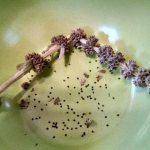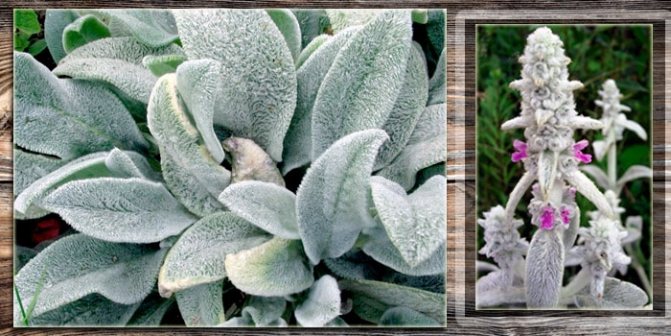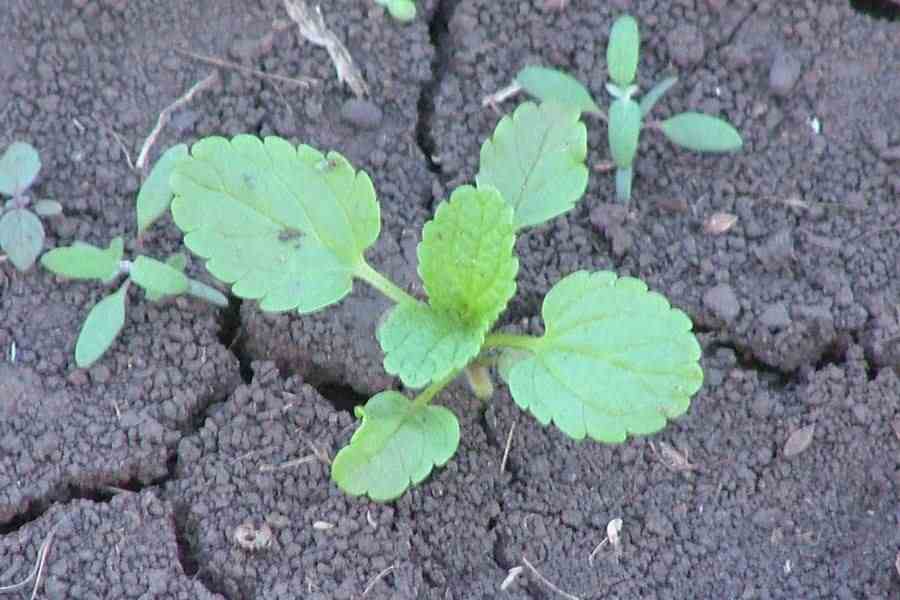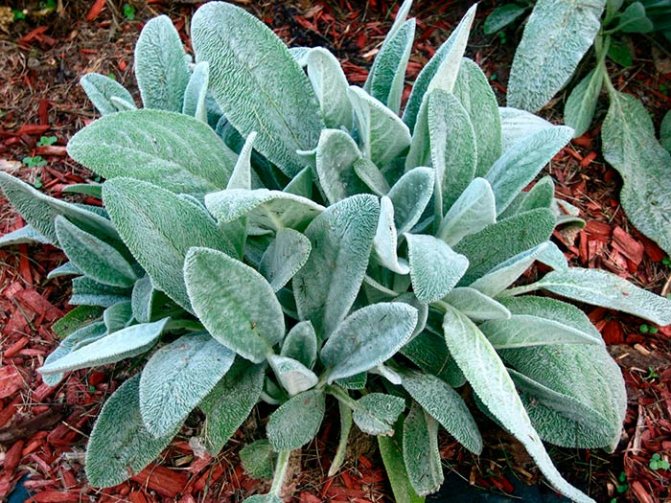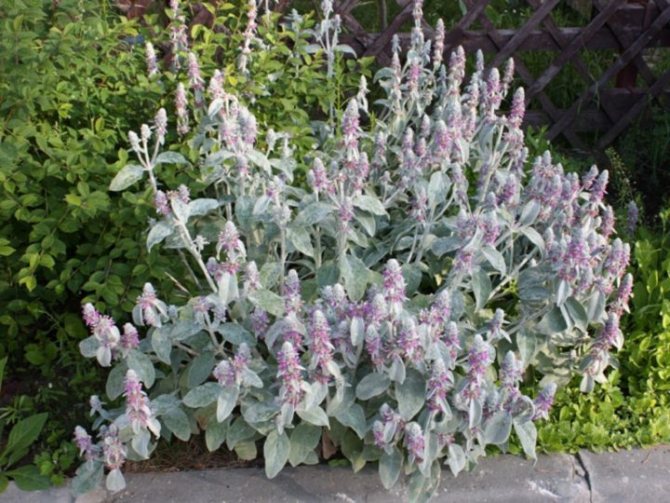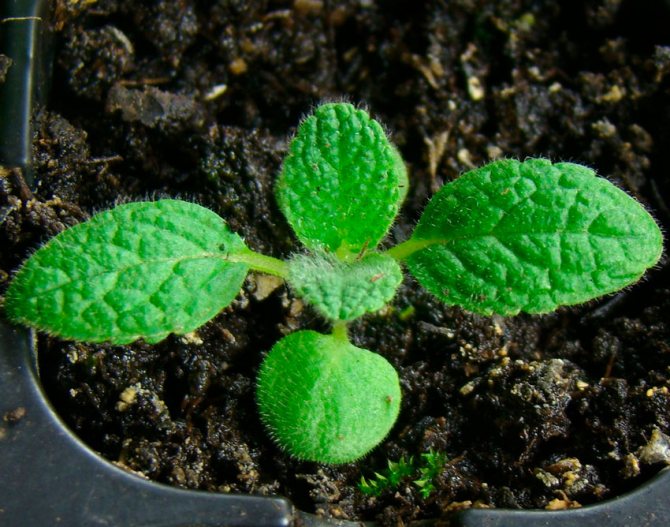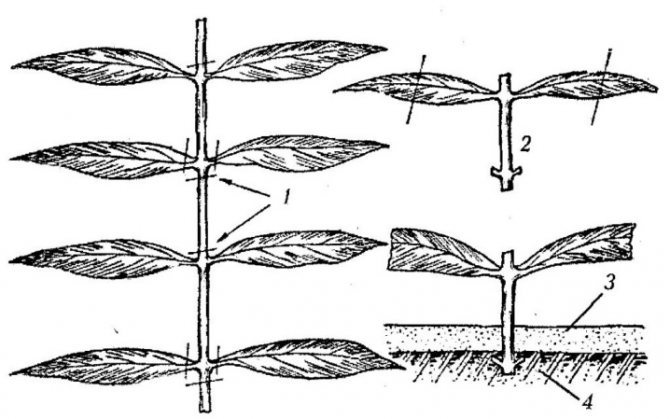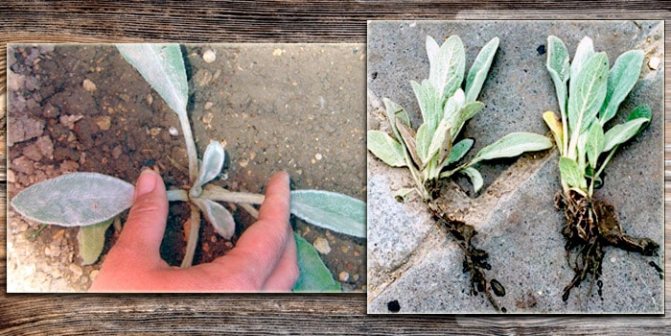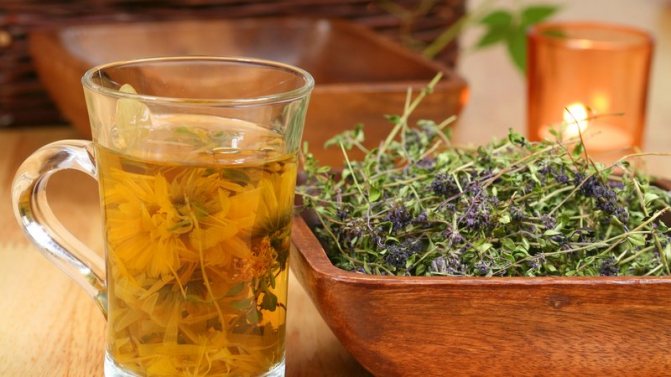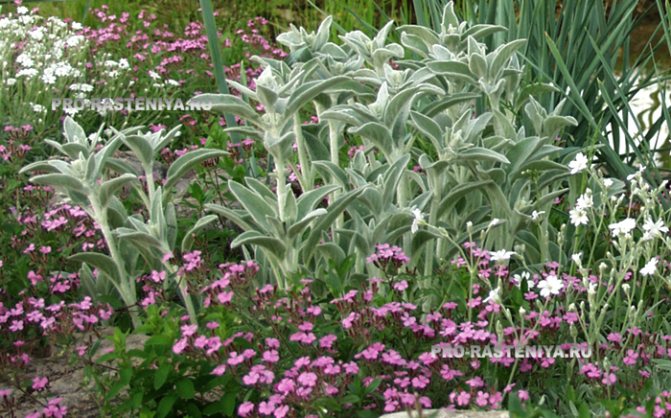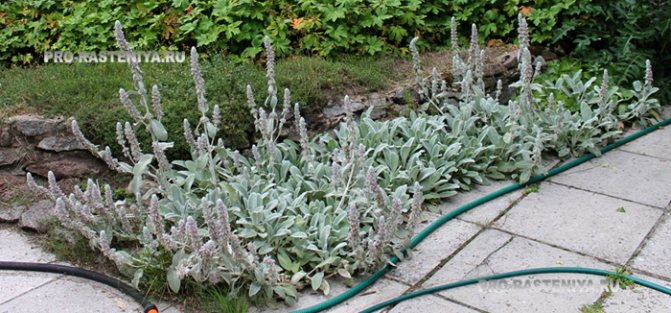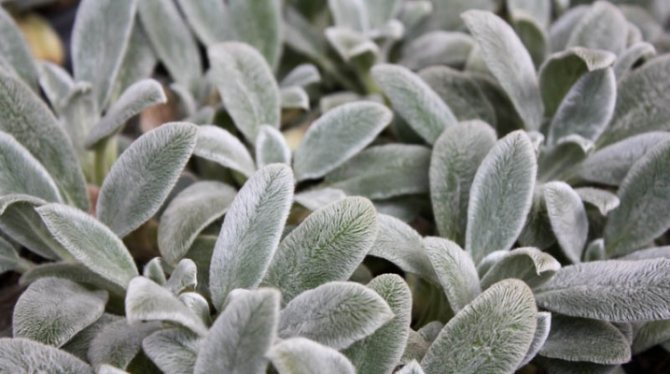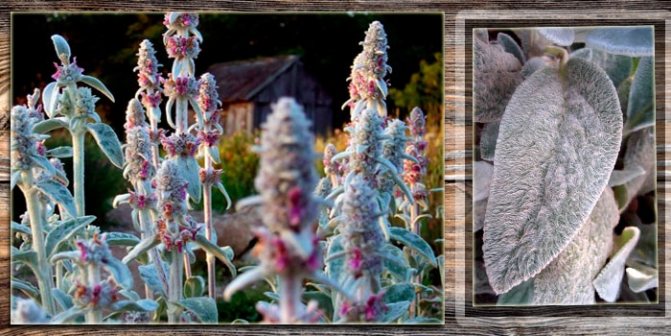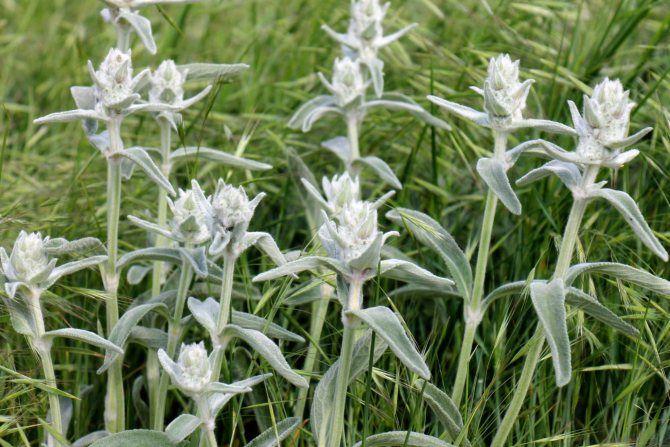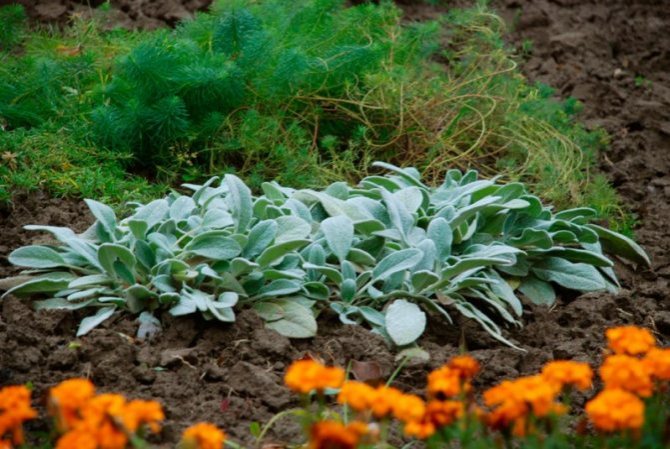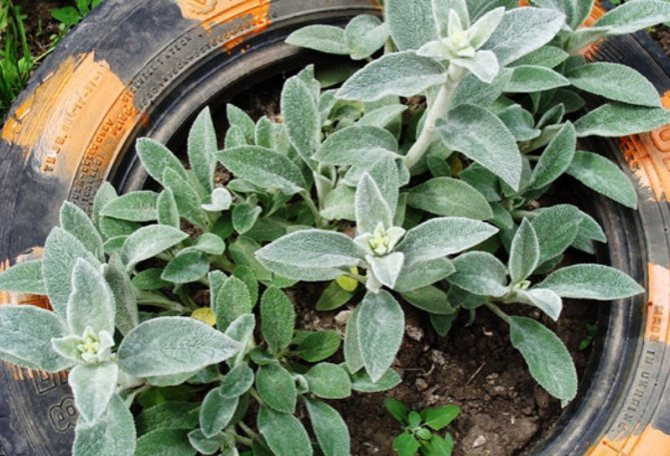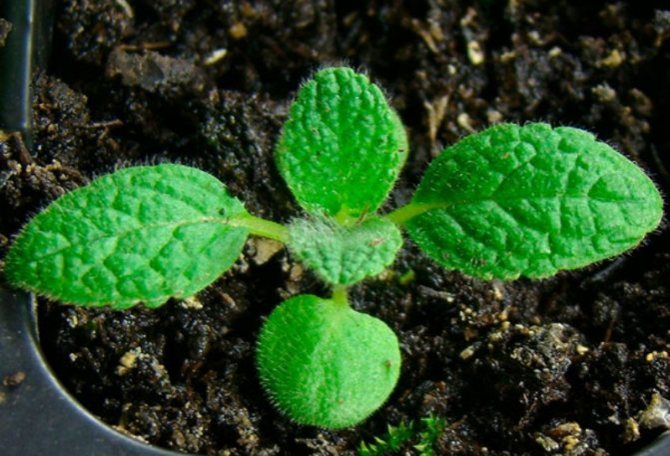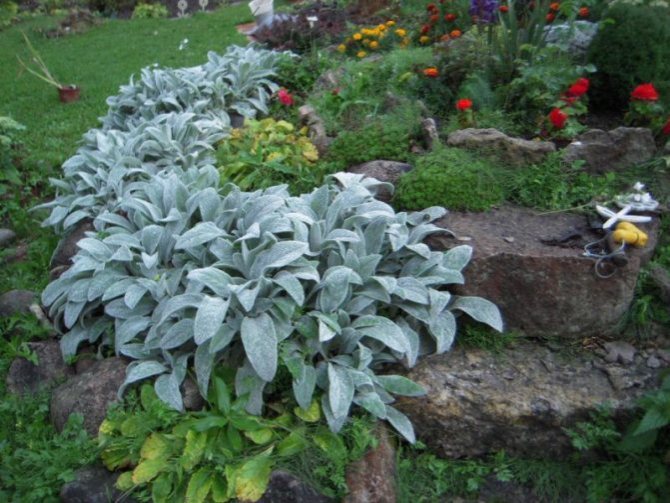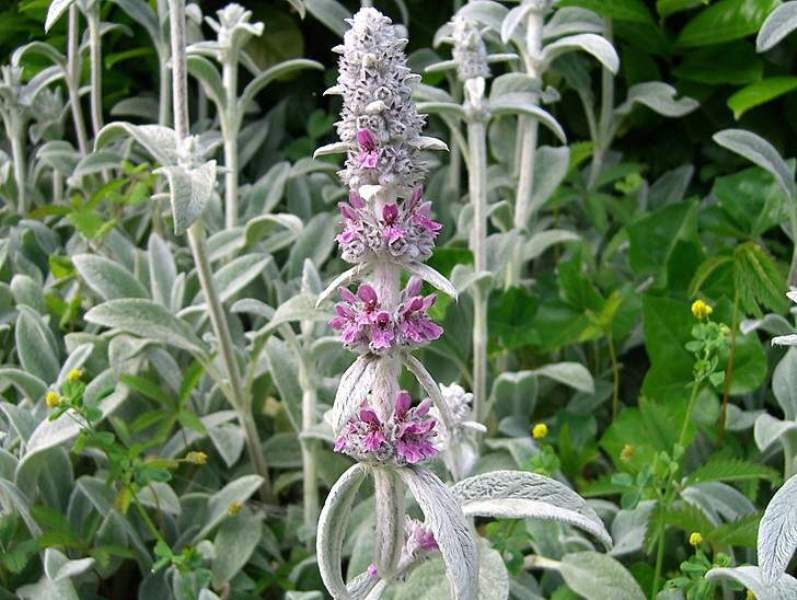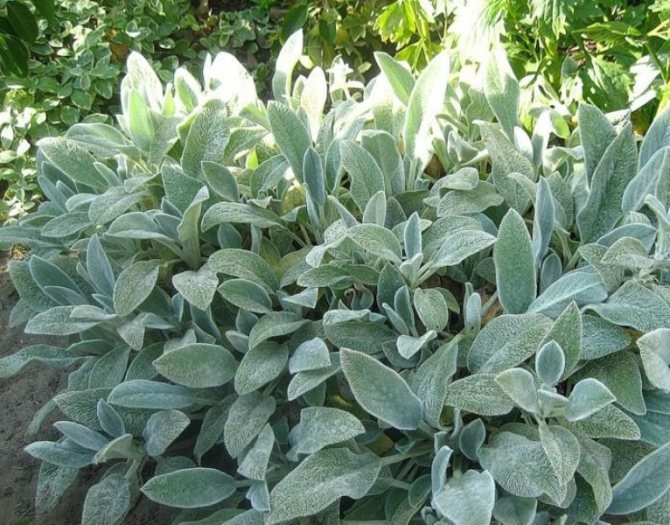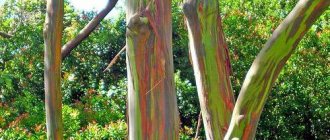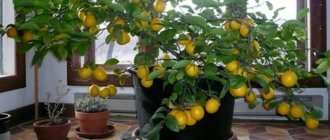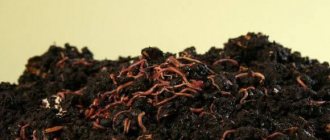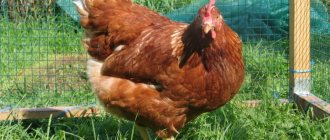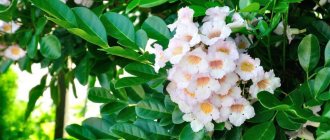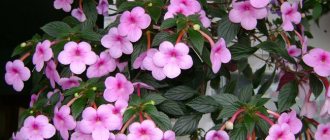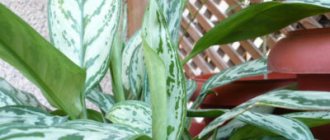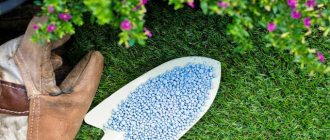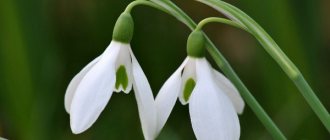Woolly chisel, often called "sheep's ears", really has amazing leaves: a silvery-gray shade with a pleasant, soft to the touch, felt texture. Natural, such an original and spectacular appearance could not but be noticed by flower growers and landscape designers. Woolly chisel is a popular perennial plant in city flower beds and backyard plots.
In addition to its aesthetically pleasing appearance, the herb is absolutely unpretentious in care, winter-hardy and easily rooted in a new place. How to plant and care for the bushes of a woolly woolen - in this selection of material.
Sheep ears growing from seeds
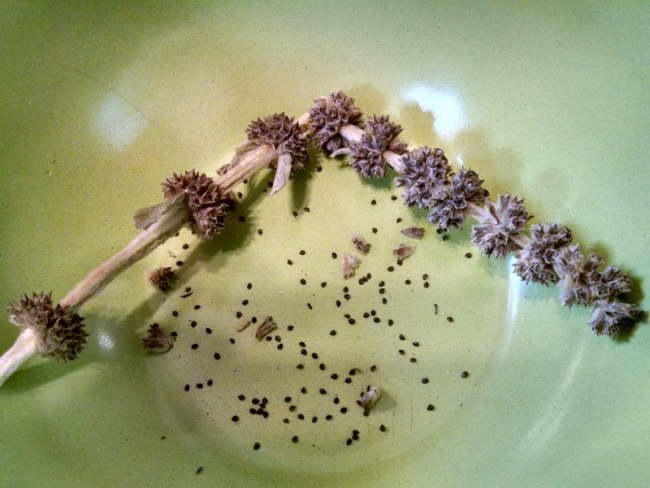
Chisel stakhis sheep ears seeds photo
In warm regions, they are sown directly into open ground in spring or before winter. Just dig up the area, sprinkle the seeds and cover with a rake. If the winters in your area are harsh, it is better to take care of growing seedlings.
The seeds germinate quickly (from 5 to 10 days) and without problems, and the seedlings are tolerant of transplanting, they can even "wander" around the site several times per season.
- Pour the sand-peat mixture into a wide container, distribute the seeds over the top, sprinkle with a thin layer of sand and spray from a fine spray.
- You can germinate without shelter, just try to spray the soil daily, diffused lighting is required, keep the temperature within 20-25 ° C.


Sheep woolly stakhis sheep ears from seeds photo shoots
- If necessary, thin out dense seedlings; before transplanting into open ground, seedlings can be grown in the same container.
- Dig holes according to the size of the root system, transfer the seedlings together with an earthen clod, when planting, adhere to a gap of about 15 cm.
Sowing seeds in open ground
The plant can be propagated by planting seeds in open ground in the spring, when the threat of night frosts has passed, or in the fall, just before the onset of winter frosts. Slightly frozen soil may also be suitable for planting, but it will need to be warmed up well.
It is very important to ensure that the outside air temperature is not lower than 8 ° C, but also not higher than 20 ° C. About 10 days after planting the seeds, the plant will give its first shoots. The percentage of germination, as in the case of germination of planting material in room conditions, is very high. After that, it will be possible to plant young crops, observing the standard distance between seedlings of 15-20 cm.
Read also: Kitchens for summer cottages design and photo
Vegetative propagation of stachis
Dividing the bush


How to divide a woolly stachis bush
After 2-3 years of growth, Byzantine Chistets can already be divided. In the spring, carefully dig out the bush along with a lump of earth, preferably manually divide it into several parts and plant it in separate holes at a distance of 15-20 cm from each other.
Propagation by cuttings
Cuttings (shoots with 2-4 leaves or individual leaves from the lower part of the stem) can be cut all season, they take root for 2-3 weeks. Plant in a damp mixture of sand and peat, but water sparingly to prevent rotting. When signs of growth appear, they can be seated separately.
Recipes: Hare Ear
Inflammatory diseases of the respiratory system: 1 tablespoon of dried flowers in 2 cups of boiling water, leave for 2 hours, drain.Usage: 1/2 cup warm 3-4 times a day with honey or sugar as tea.
Expectorant and enveloping agent: pour 1 tablespoon of dried flowers with 1 glass of boiling water, leave for 30 minutes, drain. Application: 1-2 tablespoons every 2-3 hours.
Diseases of the upper respiratory tract, shortness of breath, diarrhea, colitis and enterocolitis: 1 tbsp. l. flowers and leaves of a mullein per 200 ml of water are boiled for 5 minutes, insisted for 1 hour, filtered. Application: 2 tbsp. l. 3-4 times a day.
Landing space
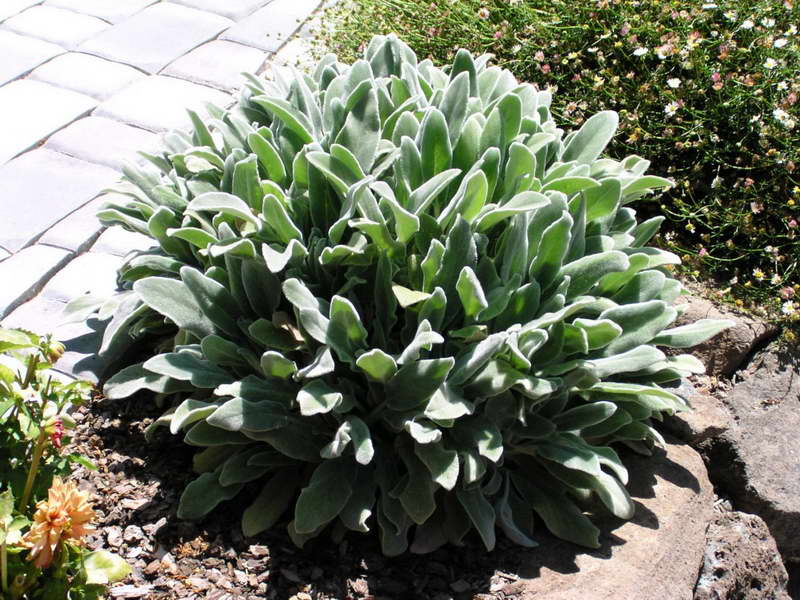

Sheep ears in the garden photo
It should be borne in mind that when grown in too fertile soil, stachis leaves may simply turn green, ornamental pubescence will be lost. The best option would be loose soil of medium fertility.
Suitable for planting are areas under bright lighting, as well as in the diffused shade of shrubs and trees. In cold light, the texture of the leaves stands out very effectively.
Cannot be grown in lowlands and flooded areas, since dampness is the main "enemy" of stachis.
Woolly scum in landscape design photo selection
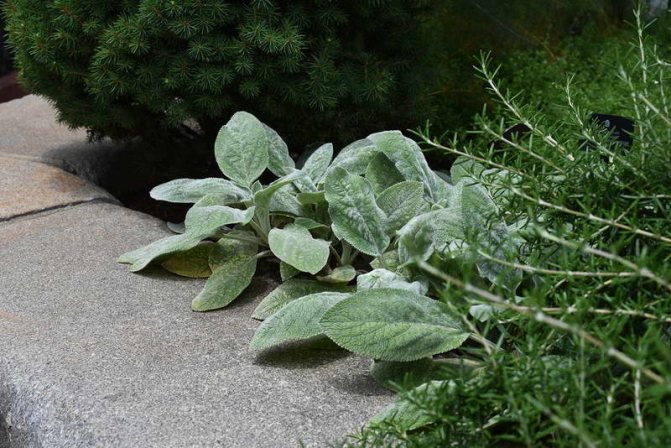

Sheep ears in landscape design photo
Bluish in color, sheep ears look spectacular against the background of bright green conifers, a beautiful combination with heather.


Byzantine chastetz at the dacha photo flower beds
The Byzantine Chistess grows superbly and pleases with the beauty of soft leaves on retaining walls, alpine hills, in rocky gardens, rockeries.


Stachis woolly and sedum on a flower bed photo
Elegant low bushes are excellent in border plantings. Used as a framing for a walkway or garden bed, creating a fabulous atmosphere thanks to the silvery shade.
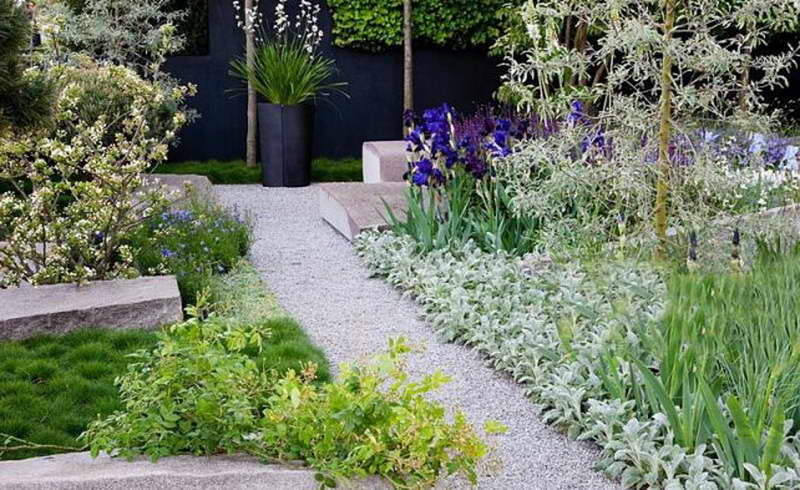

Woolly chisel in garden design photo
As mentioned earlier, partial shade emphasizes the charm of stachis, so it is often planted near shrubs and trees.
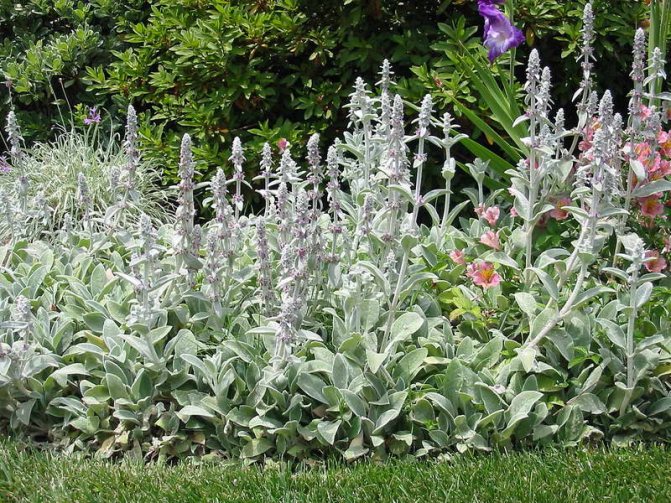

Woolly stachis in the garden photo
For neighbors, choose decorative deciduous plants of green or variegated colors. For example, echinacea, cypress euphorbia, hostu, heuchera, sedum.


Woolly stachis in landscape design photo
Due to its neutral shade, woolly stachis is perfectly combined and opens up in a new way in a duet with bright flowering plants.


Woolly chisel with other flowers in a flower bed photo
The combination with blue and snow-white flowers is especially winning, but the pink, yellow, lilac ones located nearby look no worse.
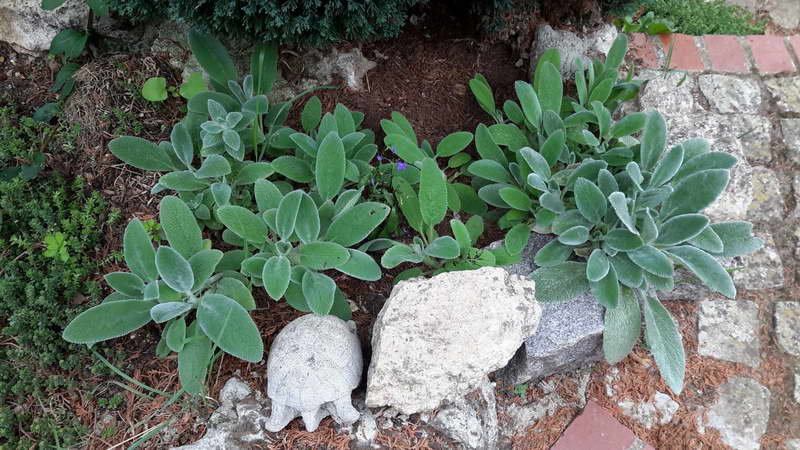

Woolly chisel in a flowerbed photo
Cuttings
As noted earlier, the plant has fairly shallow roots, so propagation by cuttings will also provide you with a quality result. Stachis cuttings are able to adapt to the new land in a fairly short time.
- Choosing a suitable material for planting from the bottom of the stem of an adult plant.
- Cut off the cuttings with a sharp disinfected knife at a right angle.
- We plant the material not too deep into the ground, keeping a distance of 15-20 cm between specimens.
Tracking the adaptation period of young plants remains the most preferable task in this method of propagation. It is also necessary to carefully monitor the level of moisture in the soil so that the roots of the stachis are not damaged by rot. At the same time, too dry soil is also undesirable, since it can dry out the roots of a young plant.
Cuttings can be carried out in early spring. In the event that the soil has not yet had time to warm up, cover it with foil for a couple of days. For this breeding method, a warm, but not too hot time of summer, autumn or spring is suitable.
Byzantine chisel, he is woolly stakhis, he is "sheep's ears" - a charming and unpretentious plant with silvery fluffy leaves.
Woolly chisel. Photo by the author
He settled in my garden for a long time: a neighbor shared the shoots, which have since turned into chic, fleecy "rugs" and spread out in different flower beds. Of course, these "ears" also came to the new garden.
The plants are still small, but in the next season they will form a pretty lawn, and after a year it will be possible to settle the scrub further.
A young plant of a purifier. Photo by the author
There are countless options for using this plant in flower beds. This is great border: Bushes without peduncles are low, grow very densely and, due to the elegant silvery color of the foliage, create an effective framing of a flower bed or garden path.
Looks great and feels great in woolly rockeries, on the retaining walls, in rocky gardens... It is undemanding to the soil, tolerates drought easily, loves light - an ideal plant for a rock garden.
The seeds and saplings of the chisel are represented in our catalog by various online stores. View selection.
On the other hand, in partial shade, it also grows well, and therefore it can be successfully planted under bushes. In such a composition, the cold color and unusual texture of the leaves of the chanterelle can become a winning accent. It is only important to make sure that the shade is not too thick, and that the neighbors are undemanding to food. On too fertile soil and with a lack of lighting, "sheep's ears" can turn green, losing their charm.
Infinite room for imagination is left by all sorts of combinations with other ornamental deciduous plants... Here, for example, how he settled down between the hosts and the cypress milkweed on the shore of the pond
Cleaner with hosts by the pond. Photo by the author
The purist's own flowers are nothing special, and tall, often unstable peduncles make the plantings untidy. Therefore, I try to cut them off; when the plant is grown as an ornamental foliage, this procedure is highly desirable. Especially, cleaning the cleaner that actually ends.
But how expressive is the luxurious, silky foliage against the background of other flowers! Thanks to its neutral color, the cleanser is appropriate in almost any composition, and will look new every time. I especially like restrained, noble combinations with blue and white colors, but red, yellow, pink, lilac look, perhaps, no worse. Here, take a look, for example: chisel against the background of flowering chives
Woolly chisel against the background of chives. Photo by the author
By the way, for planting the woolly both spring and autumn are suitable. At the same time, old, overgrown plants can be divided, the rooted shoots of which are easily separated and take root well in a new place.
I read that in regions where winters are harsh, a light shelter for plants is recommended, but mine winters well without it. And in early spring, it is enough just to remove the old, brown and dried foliage and take care that it does not stagnate at the roots water is his main enemycausing root rot and death of the plant.
I also like to iron the leaves, which are soft and extremely pleasant to the touch. Perfectly cheers up!
A leaf of a woolly chisel. Photo by the author
If your garden isn't growing yet, try to find a small corner for it. I am sure: you will certainly love these glorious "sheep ears"!
Useful properties of the plant
Byzantine Chistets and its varieties are grown exclusively as an ornamental deciduous plant. Some other types of chanterelle have medicinal properties. So, preparations based on the forest purse are used by official medicine in gynecology and obstetrics, the postpartum period. Alcohol tincture has a sedative effect, and is more effective than motherwort.The marsh purse and the pharmacy purse have anti-inflammatory, choleretic, diuretic properties.
An ornamental plant - woolly purse is used to decorate lawns, flower beds, rock gardens and other garden compositions. It is popularly known as "sheep" or "bunny ears". Another name for the plant is woolly stachis. This plant with high decorative performance is used as a garden culture for flower beds and other design objects.
Description of culture
Chistets belongs to the Yasnotkov family. Under natural conditions, the culture grows in the temperate zone: Europe, South and North America, Africa. It is an unpretentious herb that is used as a decoration in landscaping or floriculture.
No wonder he was given the name "woolly", the leaves are covered with soft-touch hairs that resemble animal hair. The leaves are elongated, in the form of "hare ears". The leaves are collected in rosettes, in the center of which a long stem with inflorescences appears during the flowering period. The height of an adult plant is up to 30 cm. Flowering is observed from June to September. Inflorescences have bell-shaped cups with sharp petals. The color can be yellow, pink, white or lilac, depending on the type of plant.
The flower is replaced by a fruit-box: a nut with three sides. Inside it are the seeds of the purifier. To achieve some decorative purposes, gardeners cut off flowering shoots, in this case the plant is used as a low-growing framing of country paths, flower beds or part of a panel composition andplants of different colors.
The roots are not branched, they go deep into the soil. On the rhizome, you can see small elongated tubers.
It is a perennial plant that predominantly reproduces by dividing the bush. Much less often seeds or tubers. Reproduction by dividing the bush also has a purely practical function: the purse grows rapidly, and in order to control its shape, it is worth periodically thinning the bushes.
Growing
Stakhis is a cold-resistant plant. In the conditions of the Stavropol Territory, it can be grown on any soil. In a highly fertile irrigated area, it forms larger nodules that are easier to select. The growing season is 130-140 days; in a damp, cool summer, it lengthens. It is not recommended to grow in areas where water is stagnant.
Agrotechnics
Stachis is grown in an annual culture. In the fall, when digging the soil, 4-6 kg of humus, 40 g of superphosphate and 30 g of potassium salt are introduced, in the spring - 20 g of carbamide per 1 m2. Planting in early April with a row spacing of 45 cm, a distance between plants of 25-30 cm, a planting depth of 6-8 cm, a planting material consumption of 12-16 g / m2. Seedlings appear in 2-3 weeks. Caring for plants consists of weeding, loosening, watering and fertilizing at the rate of 2-4 g / m2 of any of the nutrient mixtures or 1-2 g of mineral fertilizers .. It responds well to mulching between rows with a humus layer of 3-4 cm - in this case, the nodules become larger and grow to the sides of the row spacing. Watering is usually 15-20 l / m2 after 20-25 days, with drought more often and more abundantly.
When determining the harvesting period, it must be borne in mind that in August and September, stachis have an intensive growth of nodules. Therefore, it must be removed in the last decade of October. First, the tops are cut out, then the nodules are dug out. Their yield is 3-4 kg / m2.
Reproduction
Larger nodules from the autumn harvest are planted, which are stored at a temperature of 0-3 ° C. You can plant nodules from the spring digging. For this, in the fall, part of the seed plants is not harvested, only their stems are cut off, and the soil above the tubers is covered with something.
You can also plant shoots that have grown in spring from nodules left in the soil. They are chosen with soil: and nodules, placed on a new site in dug holes and immediately watered with water.
Varieties
There are no zoned varieties for food use.
Varieties for landscaping are given below
Popular varieties
The genus has about 400 species of plants, but only about ten have become popular with gardeners and designers.
Woolly chisel, or stachis. An ornamental culture that gardeners fell in love with because of the bizarre shaggy leaves. This is a hardy and unpretentious plant. It blooms from June to September with pink-purple flowers. Main varieties:
- Silver Carpet - undersized variety, bushes up to 15 cm high. When growing, forms a silvery-green carpet;
- Striped Phantom - characterized by the presence of white longitudinal stripes on the surface of the leaves;
- Sheila Macqueen is a herb without flowering. The variety is distinguished by low shoots and leaves pubescent down;
- Big Ears is a medium sized herb. They are covered with shaggy long leaves (25 cm).
The forest chase grows in Western Asia and Europe. It is a medium-sized plant with dark green leaves. Crimson inflorescences. It is a forest herb that is used in folk medicine as a hemostatic and sedative.
Another popular type of culture is the Byzantine Chistets. It is a herbaceous perennial crop. It grows mainly in the countries of South Asia, but is also found in the European part of the continent. Has a characteristic aroma. The juice contains a large amount of essential oils and vitamins of group C, therefore it is used as a medicinal plant.
The one-year-old purse is a large herb-melliferous plant. It grows in forest areas, as well as in the meadows of Europe and Asia.
The largest representative of the species is the marsh chase. The growing environment is a marshland. It is a tall herb with a powerful stem. The leaves have small denticles along the edge. Both the stem and the leaves are covered with fine villi. It is used in folk medicine as an infusion for wound healing.
Reproduction methods
Reproduction occurs in a vegetative way, less often by seeds (this type of reproduction is typical for wild varieties). Ornamental crops are planted with seeds in winter in separate boxes. to get seedlings.
The most common and easy way to reproduce an ornamental purse is to divide the bush. Thinning perennial bushes, summer residents get new planting material. Delenki take root well. Most often, the transplant is carried out in the spring.
It is recommended to plant new plants at a distance of at least 15 cm. This is due to the plant's ability to grow. Delenki with 2-4 leaves are chosen as seedlings; these are rosettes that are easily separated from the mother bush.
Watering should be done with caution, since the rhizome is sensitive to excess moisture.
Care secrets
The plant is unpretentious, but you need to follow a few simple growing rules. Following simple maintenance requirements, you can get a thick, fluffy carpet in just a few weeks. Primary requirements:
- Lighting. The purist loves light. Therefore, it should be planted in well-lit areas. Landing in partial shade is also acceptable. For example, under bushes or in close proximity to larger grasses.
- Temperature conditions. Since the plant in natural conditions feels comfortable in temperate latitudes, the optimal temperature for it is about 25 degrees. But even in the heat, the culture feels favorable under the condition of evening watering. It is a frost-resistant species. It hibernates without any problems under the snow, without special shelters. The foliage is not pruned for the winter, but some gardeners prefer pruning the plant from older shoots.
- Soil requirements. In principle, the type of soil is not a fundamental factor. Stachis can exist in any soil composition. However, do not plant in nutrient-rich soil, moderate fertility is most acceptable.With an excess of nutrients, the plant loses its decorative appearance. The leaves turn bright green, while losing their muted silvery hue.
- Watering. This is a plant that loves moderate watering. It survives drought well. But excess moisture can lead to rotting of the rhizome and the plant as a whole.
- Food. Top dressing should be done regularly during the flowering period. This will prepare the culture for wintering. Fertilizers are used of organic and mineral nature. Dung (chicken or cow dung), ammonium nitrate or mineral complexes will do.
- Pruning. After the flowering period, the peduncles should be removed. Some cut them before flowering, in the event that there is a need to use the culture as a living carpet without flowers. The plant loses its decorative appearance in the flowering phase: the foliage is thinning, the bush is stretched out, “bald spots” appear. Before wintering, the lower leaves are removed, as well as fragments with defects.
- Diseases. Stachis can suffer from fungal diseases. This happens if the plant grows in high humidity conditions or after heavy rains. The plant repels insects with its nap and specific smell, so pests do not threaten the culture.
Application in garden decoration
The unique appearance of stachis allows you to diversify garden compositions. In addition, the plant is able to decorate flower arrangements. It is used by:
- When creating edging for garden paths and flower beds. Fluffy leaves look great in multi-layered borders.
- As the main and additional element in rockeries, rock gardens or flower beds.
- As a garden decor as an ampelous plant. When planted in a pot, you can hang it on the terrace or balcony.
- For drawing up live and dry floristic compositions. The foliage retains its decorative appearance for a long time.
The plant is combined with flowering and deciduous crops. For example, excellent combination with marigolds, bellflower, ageratum, deciduous crops: hosts, milkweed, conifers dwarf shrubs.
Use in traditional medicine
Some varieties of Chiseta have beneficial properties and are effectively used in traditional medicine. The stem, leaves and roots contain tannins, pectins, essential oils, polysaccharides and beneficial acids. The purist possesses:
- anti-inflammatory properties;
- hemostatic and healing effect for wounds and suppurations;
- expectorant properties for colds and respiratory diseases;
- diuretic effect, which makes it possible to use in diseases of the genitourinary system.
The herb is used in folk medicine dry and fresh... From the plant, infusions are prepared on alcohol and oils, which are used as rubbing or in the form of compresses, bandages. The broth is used for washing wounds, as well as for ingestion. Decoction-based baths and lotions are effective.
A spectacular ornamental plant can not only decorate the garden, but also become a living pharmacy for the owner.
Chisetz is a herbaceous perennial plant, often referred to as "sheep's ears". Such it got its name thanks to the fleecy leaves, which outwardly very similar to the ears of an animal. Another name is stakhis. In translation, the word means "ear", which characterizes the produced inflorescences. The plant is used as a decorative element for framing a flower bed or path, it also looks good in rockeries and other rocky compositions. The scrubber has no special requirements for the soil, easily tolerates a lack of moisture.
Rabbit ears (flower): photo, application, treatment, description
• Botanical characteristics, description
Hare ear, translated as Verbascum lychnitis, the second name of the plant is mealy or paniculata mullein, it is a herbaceous biennial, its branched stems are densely covered with tiny hairs, they are stellate, painted in a grayish-green color. Height can reach 160 centimeters. The leaves are ovoid or lanceolate.
The inflorescence of this representative of the flora is represented by a pyramidal panicle, the flowers are contiguous; the corolla is yellow in color, less often it is white, up to two centimeters in diameter, with transparent dots, some pubescence can be seen outside. The fruit is shaped like an elliptical capsule.
This plant grows in the chernozem area, it can be seen on rocky terrain, in dry meadows, and it is also localized along roads, sometimes growing along shelter belts in the chernozem zone of the European part of Russia, in the northern banks of rivers.
This plant is used as a whole, for medicinal purposes, it uses roots, flowers, leaves and stems. Various drugs are prepared from its raw materials that help with certain diseases, among the components the following compounds can be noted: carbohydrates, ascorbic acid, myoinositol, iridoids, tannins, saponins, alkaloids, coumarins, flavonoids, alcohols, ursolic acid, alpha-spinasterol, and some other components.
• Collecting and harvesting a plant
In order to prepare the grass of the hare's ear, you must wait for its flowering. After that, with a sharp sickle or shears, cut off the required amount of raw materials and sort it qualitatively, while paying attention to the presence of damaged and rotten specimens, which should be discarded from the bulk.
Next, the raw materials are laid out on a flat container, for example, you can use a pallet, it is desirable to cover it with paper, after which the grass of the hare's ear is laid out in a thin layer. It is worth knowing that it is necessary to turn the harvested plant every day to prevent it from becoming damp with subsequent decay.
general description
Stakhis belongs to the genus Chistets and the Lamb family. In the wild, the plant can be found in Armenia, Iran, Ukraine, Turkey. Also found in the southern territories of Russia. Prefers mountain slopes, rocky terrain in mixed coniferous forests.


The semi-shrub grows up to 60 cm in height due to inflorescences, while the main part of the plant rarely exceeds the threshold of 20-30 cm. The root system is weakly branched, goes deep enough into the ground. In one season, many shoots grow from the rhizome, which soon form real thickets of the chitosene.
The stems are straight or branched, the color is silvery-gray, have a characteristic felt covering. The leaves are considered the most decorative and attractive part of the plant - they are gray-green, pubescent due to numerous villi.


In the photo you can see its inflorescences. They are represent an ear on which there are many small flowers. They have no particular decorative effect, so many gardeners simply cut them off. The color of the petals is pink or lilac, long stamens protrude at the top.
At the end of the season, under favorable conditions, stachis produces many seeds. The tubers of the plant are used for food. They are especially useful for diabetics by lowering blood sugar. In principle, the whole cleanse is recognized as medicinal; tinctures and decoctions are made from it.
Features of the purifier
The aerial parts of the stachis are covered with dense pubescence, even its leaf plates. In this regard, this plant is also called "Chistets - sheep's ears". The height of the bush can be up to 100 centimeters. Opposite leaf plates can be solid or serrated. Flowers are part of false whorls, which in turn form spike-shaped inflorescences. The color of the flowers can be purple, yellow, lilac, pink or white.The fruit is a triangular nut, ovoid or oblong in shape.
Varieties
Woolly chisel is a common species, so a lot of varieties have been bred from it. Let's highlight the most popular ones:
- "Big Ears"- as it is easy to guess from the name, which in translation means "big ears", the variety is distinguished by the increased size of the leaf plates. The height of branchy shoots does not exceed 25 cm.
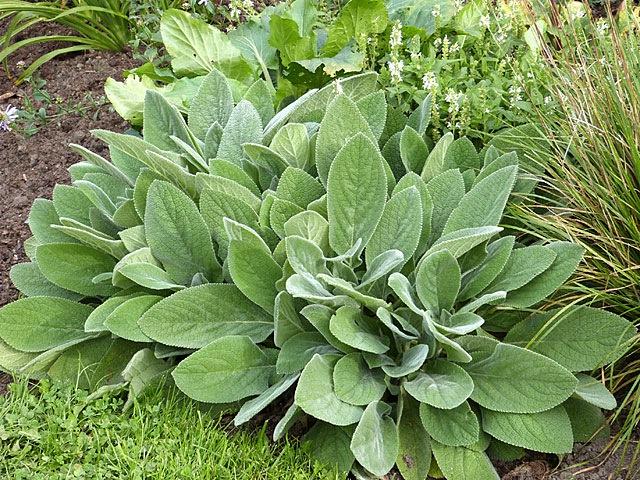

- "Silver Carpet" - the “silver carpet” variety forms small curtains up to 15 cm high. Growing up, it creates a continuous covering of a silvery-gray shade. Flowers does not throw away.
- Striped Phantom - the name "striped phantom" characterizes the presence of longitudinal stripes over the entire surface of the sheet. This variety is considered one of the most beautiful among variegated ornamental plants.
- "Cotton Ball" - at the flowering stage, small seed pods grow, which in appearance resemble cotton.
- Sheila Macqueen - a low-growing plant, has an increased number of hairs on the leaves, does not bloom.
- Marvel. A distinctive feature - the height of the bush reaches 50 cm.
- "Primrose Heron" - differs in the color of the leaves. In spring they are yellow, and with the onset of summer they acquire a more familiar silvery hue. The petals on the inflorescences are pink.


Woolly stachis varieties with photos and names


Chistess Byzantine variety Helen Von Stein photo
The Helen Von Stein variety is distinguished by its large bursty leaves with a velvety surface; in the flowering zone it does not lose its decorative effect: bluish woolly shoots with flowers stand out effectively against the background of brighter neighbors.
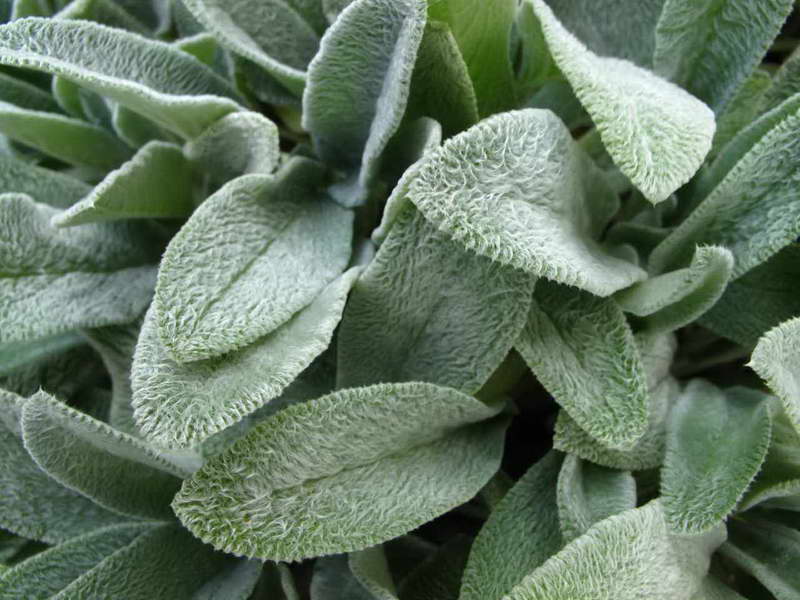

Stachis woolly Stachys byzantina ‘Big Ears’ photo
Big Ears is a short plant with shaggy leaves up to 25 cm long.
Sheila Macqueen and Silver Carpet are compact bushes with a height of about 15 cm. Both varieties do not bloom; when planted tightly, they create a ground cover effect.
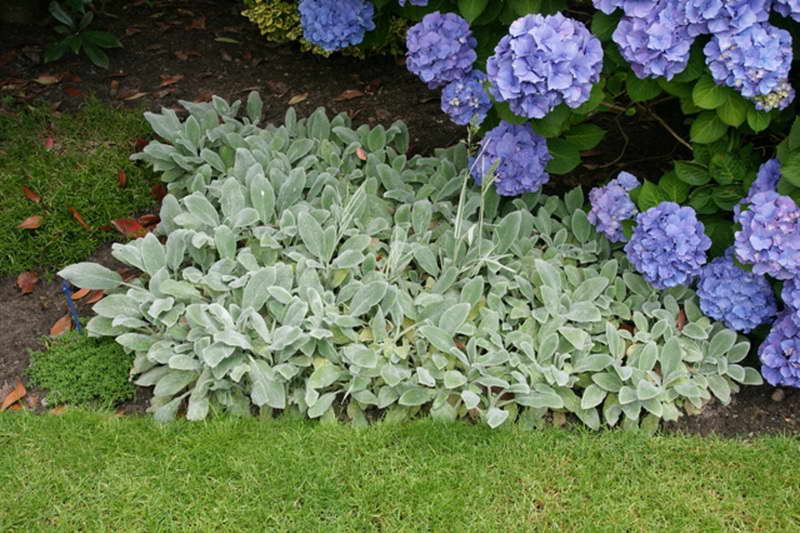

Woolly beetle Stachys byzantina Cotton Ball photo
Cotton Ball - you probably shouldn't pick off the flowers, because the inflorescences look like cotton bolls.


Stachys byzantina ‘Striped Phantom’ photo with other colors
Striped Phantom - leaves with white longitudinal stripes, bright yellow flowers.
Woolly chisel: planting and care
The plant is quite unpretentious both in terms of reproduction and subsequent care. The most favorable location is in the sun, slight shade is allowed. Almost any soil is suitable, watering is moderate - it is better to underfill the plant. More on all points below.
Reproduction
The emergence of new representatives of the species is provided by a generative (seeds) or vegetative (dividing a bush or rhizome, cuttings). Seeds are sown directly into open ground or for seedlings. In the first case, sowing is carried out in the fall, in the second - in the spring (March).
For growing seedlings, an appropriate container is used, filled with a soil mixture of sand and peat. The seeds do not go deeply, they need to be sprinkled a little with soil on top.
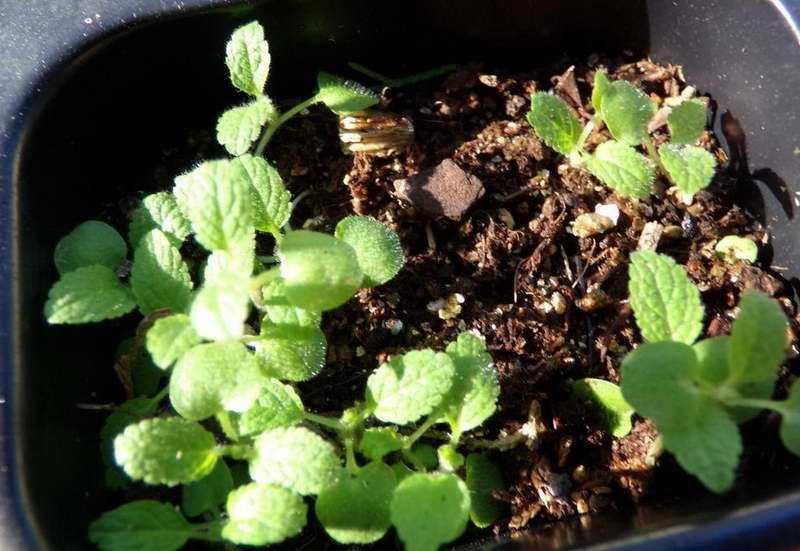

The container is covered with foil and placed in a warm place. Airing is carried out daily. Seedlings are thinned out without replanting. When the seedlings reach development of several leaves, they are planted outside. Usually, the appropriate conditions come in May. The sprouts do an excellent job of transplanting and quickly take root in a new place.
It should be noted that in young plants the leaves are not fleecy at first. The characteristic hairs appear with age.
Vegetative division of woolly stachis is carried out in spring or cool summer. You can break the bush into several parts right in the ground with a shovel. If you want to act more delicately, then the plant is completely dug up, shaken off the ground and separated. Newly formed bushes are immediately planted in a permanent place of growth.
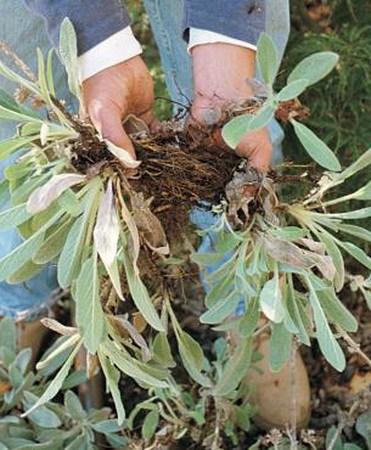

Division can be done using the root itself. It is also divided into parts and simply landed in the ground.
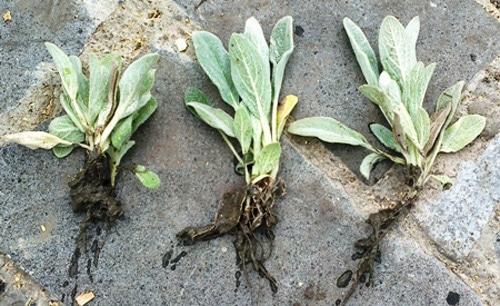

For cuttings, the lower parts of the shoots, on which 2-4 leaves are located, are suitable. The leaves themselves are also used, separated from the lower rosettes. The cuttings method can be carried out throughout the growing season. To root the shoots, they are placed in a moistened mixture of peat and sand.The substrate is kept moist until the plant takes root - this happens on average after 2 weeks. Then a transplant is made to a permanent place.
Care rules
The Byzantine chastetz is so adored by many gardeners precisely because of its unpretentious care. All activities are reduced to periodic watering, feeding, removing flower stalks and planting new bushes. Pests do not attack the plant, and it rarely suffers from diseases.
The nuances of watering and loosening the soil:
- Stachis is resistant to drought and stagnation of moisture in the roots, which can provoke decay, is very undesirable for it.
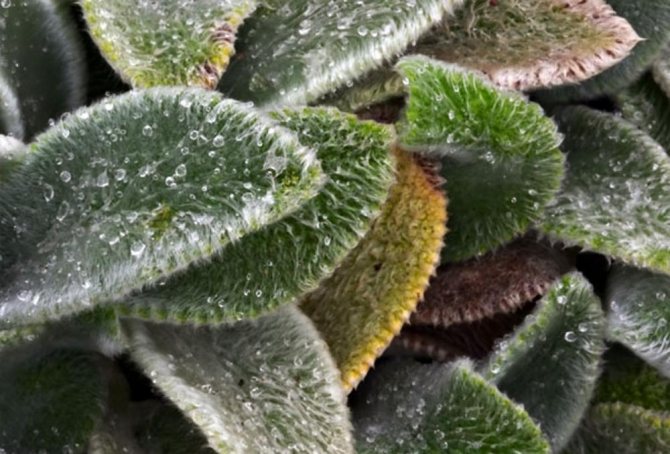



Frequent feeding of the plant is not required, although it will be "grateful" for the compost introduced into the soil. To enhance growth, you can use ammonium nitrate mixed with chicken droppings. Such feeding is performed rarely and in minimal doses.
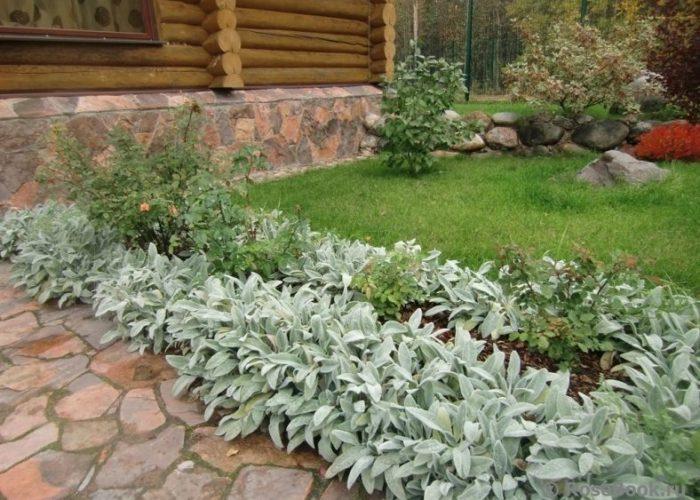

If the flower "bear's ear" shown in the photo is a decorative element of the garden, then it is very important to prune it. A neat look of fleecy leaves is achieved by removing periodically arising peduncles. A bush with inflorescences thrown up loses its compact appearance, becomes less attractive from an aesthetic point of view. Peduncles are removed as close to the ground as possible, along the way, dry and spoiled leaves are removed.
In the spring, sanitization is carried out over the stachis: dry shoots and leaves, bare rhizomes are cut off. Also remove bushes that have grown outside the allocated area. If the cleaver is planted as a ground cover plant, then you will have to deal with bald patches by planting new bushes. Gaps in the growth appear at 3-4 years of plant life.


Chisel is resistant to frost, therefore shelter for the winter is only necessary in case of harsh winters. As a protection, the plant is covered with spruce branches or dry foliage. It is extremely important not to forget to open the flower in spring in time - it is much more likely to rot rather than freeze out.
Fight disease
The donkey ears flower is not attacked by pests, very rarely, troubles can arise only in relation to diseases. If the plant is affected by a fungus, the reason for this is high humidity. It is necessary to ensure the free passage of air between the shoots and the drying of the soil.


Spraying with fungicides is used to destroy the fungus. If the bush is badly affected, it is better to dig it up and burn it. - this will prevent further spread of the disease.
Features of care for "bunny ears"
The indisputable advantage of this type of plant is the almost complete absence of requirements for care. The purist needs only minimal agrotechnical procedures - periodic watering, pruning flower stalks and replanting young seedlings to preserve the ground cover effect and rare dressings.
As for the humidification regime, being a representative of one of the most drought-resistant crops, the purse easily tolerates aridity, prefers moderate watering, which is carried out every time after the topsoil is completely dry. It is advisable to try to carry out the procedure under the root, avoiding the ingress of water on the leaves.
An important part of planting maintenance is loosening the soil and removing weeds. First of all, this is important for preserving the decorative appearance of the bushes, and the procedure also relieves the cleaner from "uninvited guests" who take away part of the micronutrients from him.Top dressing is mainly carried out in order to enhance plant growth and accelerate the formation of dense plantings. For this, ammonium nitrate and a solution of chicken manure in minimal dosages are introduced under the root.
Cutting peduncles is used exclusively at the request of the gardener. It is carried out to preserve the low growth of plantings, to stimulate the development of the green part of the plant, when there is no need to waste energy and energy on flowering. Pruning of old dry leaves and rhizomes bare with age is carried out in the spring before replanting young specimens.
Since the plant is characterized by frost resistance, it practically does not need insulation for the winter. Only in the coldest regions, and regions with severe winters with little snow, the purse needs shelter, which is used as a spruce branch or dry foliage that has fallen from healthy trees.
It is important in the spring to have time to remove the warming natural material from the green part of the plants in time, preventing the beginning of the debate process.
Stakhis or woolly purse photo, description, planting and care, reproduction, tubers, seeds. Food use, recipes. Use in landscape design.
Stakhis is a plant of the Lamb family that looks like mint and has long been cultivated in China and Mongolia. It has several other names: Chinese artichoke, khorogi, chisetz. In Russia, a cultivated species was introduced from Mongolia in 1975.
Stakhis is the generic name for a number of species, which include:
- Marsh purse
- Byzantine synonym Chistets - Byzantine Stachis
- German chistess
- Forest scrub
- Woolly chisel synonym - Woolly Stakhis
The correct scientific name of the Woolly Chistets (Stachys lanata) is Byzantine Chistets, and the Latin name is Stachys byzantina
> Application
Using. They mainly eat stachis nodules.
Its leaves are also used in salads.
Boil 500 g of stachis in salted water for 5-6 minutes, discard in a colander and fry in butter. Serve with meat, fish as a side dish.
Woolly chisel or "Sheep's ears" is a perennial herbaceous crop of the Yaroslavl family, growing in coniferous and mixed forests, in forest and forest-steppe areas. The plant is also cultivated in home gardens for future medical use. Popular names for the chisel are hare ears and the Byzantine chisel. The first name was invented because of the white edge on the leaves of the culture.
The plant is considered perennial, has massive elongated leaves tapering downward. They seem to be wrapped in light gray down, which makes them especially decorative and beautiful. The flowers of the culture are small, lilac-pink and lilac in color, in dense spike-shaped inflorescences, placed on oblong peduncles. Chisetz blooms in June-September. Due to the fact that the peduncles are elongated, they often fall on the ground due to rains.
Beneficial features
In the course of official research, it was found that The woolly purse stops blood, is an antiseptic and pain reliever, helps to heal wounds and increase urination. It is low-toxic, destroys staphylococci and microbes. In addition, "sheep's ears" help calm the nervous system and lower blood pressure.
The alkaloid stachydrine included in the composition enhances blood clotting. The substance raises the tone and increases the intensity of uterine contractions - these properties make it possible to use the purifier for uterine bleeding and during the recovery of the genital organs after childbirth.


Having memorized the stachis from the photo, it can be used in folk medicine. The tubers are ground into powder and are part of the decoctions that help improve expectoration, cure sore throat and tuberculosis. A water decoction of the leaves has a positive effect on the heart muscle, reduces blood pressure.
Alcohol tincture soothes, stops uterine bleeding.The infusion treats skin diseases, scrofula, gout, neurosis, depressive conditions. A fresh leaf plucked from a bush helps to remove an abscess, heals a cut, wound or ulcer. Quite often, stachis is part of the treatment fees that help with epilepsy, tantrums and fainting. Its active substances lower glucose levels, therefore, are indicated for people suffering from a mild form of diabetes mellitus.
Application: Rabbit Ear
In practical and traditional medicine, it is used as an anti-inflammatory for gynecological diseases, as well as in the postpartum period. Infusion of flowers, less often leaves, is used for coughs, bronchitis, pneumonia, whooping cough, hemoptysis, inflammatory diseases of the digestive system, bronchial asthma, hoarseness, shortness of breath, acute respiratory infections.
Tincture of flowers is used for rubbing as an analgesic for rheumatism, arthritis and neuralgic pain. Powder of flowers is sprinkled with cracks on the nipples, wounds, having previously lubricated them with carrot juice.
The scalded flowers or leaves of the mullein are applied to inflamed areas, burns, wounds as an anti-inflammatory, wound healing and analgesic agent. Infusion of flowers, less often leaves, are used to rinse the mouth and throat in case of inflammatory processes.
The decoction of the roots is used for baths and washings for hemorrhoids. The infusion and the amount of flavonoids in the experiment have cardiotonic, hypotensive, sedative and anticonvulsant properties. The infusion of flowers is recommended for clinical trials as a cardiotonic agent. Water, ether and chloroform extracts exhibit antibacterial activity. The seeds of the plant were previously included in ointments for the treatment of long-term non-healing wounds.

